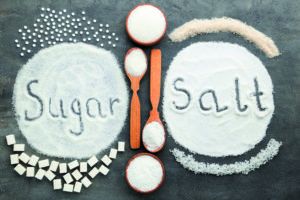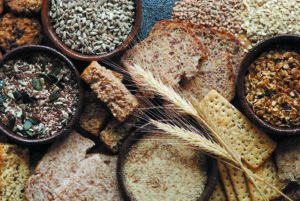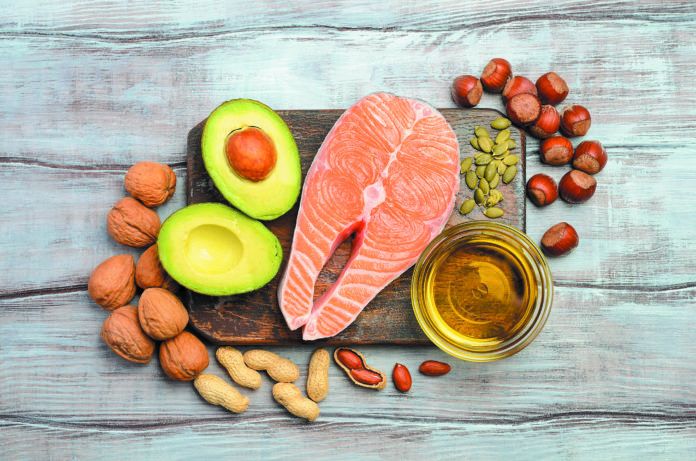Simple swaps—like choosing foods with unsaturated fats to replace those with saturated, unprocessed or reduced sodium foods over typical high-sodium processed products, fruits instead of foods with added sugars, and whole grains in place of refined—have been identified as important steps for improving the diet quality of the U.S. population. These easy exchanges are practical steps you can take now to protect your heart and brain health.
Flip Your Fats
Not all fats are bad, in fact, some are good. Saturated fats are clearly linked to increased risk of high LDL cholesterol, atherosclerosis, heart attack, and stroke. Fortunately, studies have shown that replacing saturated fat with monounsaturated and particularly polyunsaturated fats found in plant foods (such as vegetable oils, avocados, nuts, and seeds) is an effective way to improve cardiovascular health.
Meat (including beef, pork, and lamb) and full fat dairy products are a major source of saturated fat in the U.S. diet. Cutting back on red meats and full fat dairy products and filling that “protein” spot on your plate with plant proteins (like beans, lentils, and soy), fish and other seafood, skinless poultry, or low- and nonfat dairy products is a sensible swap for heart and brain health.
Don’t just cut fat from your diet. Replacing saturated fats with unsaturated fats is key. Instead of cooking with solid fats like butter, lard, traditional shortenings, and tropical oils, which are high in saturated fats, use liquid plant oils. Soybean, canola, olive and corn oils are good choices that are commonly available, and you may see safflower, sunflower, and their high oleic versions in the cooking oil section of most markets as well. (High oleic oils are made from seeds bred to be higher in mono-unsaturated fats.) Various nut and seed oils as well as avocado oil are available for a price. These products may impart a particular flavor that works well with certain recipes (sesame oil for stir-fries, or walnut or avocado oils for a salad dressing) but they can be expensive and do not have any particular health benefits above their less expensive counterparts. Any liquid plant oil that meets your taste preferences and cooking needs is a reasonable choice for your health. The important thing is to use them in place of animal fats and tropical oils such as coconut, palm, and palm kernel which are high in saturated fat and should be avoided.

Image © 5second | Getty Images
Cut Down on Added Sugars
Diets high in added sugars are associated with higher blood pressure, lower HDL (good) cholesterol levels, elevated triglyceride levels, weight gain, and obesity, which are all linked to a greater risk of cardiovascular disease. Even though they contain some sugar, fruits, vegetables, and dairy are not associated with these negative health effects.
U.S. dietary recommendations call for limiting added sugars to less than 10 percent of total calories per day. In a 2,000-calorie daily diet, that means no more than 200 calories from added sugar. This is around 12 teaspoons of sugar, or about the amount in one regular 16-ounce soft drink. The American Heart Association recommendations go even further: women and children should keep added sugar intake under six teaspoons (around 25 grams) a day, and men should have no more than nine (around 38 grams).
You can start reducing your added-sugar intake by skipping sugary sodas and other sugar-sweetened beverages. Nearly half of the added sugars consumed in the U.S. come from sodas, sports drinks, and fruit drinks. And don’t overlook those “gourmet” tea and coffee drinks—even a small iced chai or mocha Frappuccino may contain as many as 15 teaspoons of added sugar.
An estimated 75 percent of packaged foods purchased in the U.S. contain added sugars, which include healthy-sounding sweeteners like honey, maple syrup, brown rice syrup, and concentrated fruit juice along with the ubiquitous high fructose corn syrup and sucrose. Candy and desserts are obvious culprits, but sugar also is added to foods like ketchup, salad dressings, breads, bagels, and baked beans. The Nutrition Facts label now requires a line for added sugars that’s separate from the line for total sugars. If a food doesn’t have a Nutrition Facts label (like fruits, vegetables, and meats), one can be confident it has no added sugars.
Sub for Sodium
Cutting down on packaged foods, eating more home-cooked meals, and reaching for herbs and spices instead of the saltshaker are three important strategies for controlling blood pressure and protecting vascular health. Unfortunately, the vast majority of adults in the U.S. consume too much sodium. Excess sodium causes your body to retain extra water, which increases blood volume and blood pressure in your circulatory system, resulting in high blood pressure (hypertension). Many people with hypertension can lower their blood pressure by limiting intake of sodium chloride—the chemical name for salt – and other sources of sodium. (Additionally, increasing intake of fruits and vegetables provides potassium and other minerals that help to lower blood pressure.)
Experts advise that most people would benefit from cutting down on their sodium intake. The Dietary Guidelines for Americans recommend a 2,300 milligram (mg) sodium maximum. An estimated 70 percent of the sodium in the U.S. diet comes from processed, packaged, and restaurant foods, rather than occurring naturally in foods or being added during cooking or at the table. If you eat out frequently, preparing more meals at home is one strategy that will reduce your sodium intake while also improving your overall dietary quality. When you opt for the convenience of canned products such as beans and tomatoes, choose no-salt-added, reduced sodium, or low sodium products, or drain and rinse them to remove excess sodium. Check Nutrition Facts labels on food packages for sodium content and choose the product with the least sodium. As a general guide when looking a labels: a Daily Value of five percent of sodium or less per serving is considered low, and 20 percent or more is considered high.
Use more herbs and spices and less salt in the foods you prepare (check spice blends to make sure salt is not a major ingredient). Adding a splash of lime or lemon juice or vinegar also can perk up the taste of low-sodium foods.

Image © RosetteJordaan | Getty Images
Replace Refined Grains
Dietary patterns that include high intake of refined grains (like white flour and the breads, crackers, cookies, and pastries made from it) have been associated with elevated risk of cognitive decline and cardiovascular disease, as well as obesity and type 2 diabetes. Refined grains are lower quality than whole grains because refining removes fiber and many other health-promoting compounds. In the U.S., refined flour must be enriched with a number of the vitamins and minerals (thiamin, riboflavin, niacin, folate and Fe) removed in processing, but enriched flour still does not match the nutrient profile of whole wheat flour. In addition, refined grains are often mixed with added sugars (as in cakes and sweet breakfast cereals), salt (like crackers, pretzels, and quick-cooking flavored rice dishes), and saturated fat (as in pie crusts and other baked goods). The 2015 Dietary Guidelines for Americans recommend making at least half of all the grains you eat whole grains.
- Breads & Rolls
- Pizza
- Sandwiches
- Cold Cuts & Cured Meats
- Soup
- Burritos & Tacos
Choose wisely, read nutrition labels, and watch portion sizes.





















